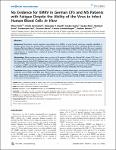No Evidence for XMRV in German CFS and MS Patients with Fatigue Despite the Ability of the Virus to Infect Human Blood Cells In Vitro
Hohn, Oliver
Strohschein, Kristin
Brandt, Alexander U.
Seeher, Sandra
Klein, Sandra
Kurth, Reinhard
Paul, Friedemann
Meisel, Christian
Scheibenbogen, Carmen
Bannert, Norbert
Background: Xenotropic murine leukemia virus-related virus (XMRV), a novel human retrovirus originally identified in prostate cancer tissues, has recently been associated with chronic fatigue syndrome (CFS), a disabling disease of unknown etiology affecting millions of people worldwide. However, several subsequent studies failed to detect the virus in patients suffering from these illnesses or in healthy subjects. Here we report the results of efforts to detect antibody responses and viral sequences in samples from a cohort of German CFS and relapsing remitting multiple sclerosis (MS) patients with fatigue symptoms. Methodology: Blood samples were taken from a cohort of 39 patients fulfilling the Fukuda/CDC criteria (CFS), from 112 patients with an established MS diagnosis and from 40 healthy donors. Fatigue severity in MS patients was assessed using the Fatigue Severity Scale (FSS). Validated Gag- and Env-ELISA assays were used to screen sera for XMRV antibodies. PHAactivated PBMC were cultured for seven days in the presence of IL-2 and DNA isolated from these cultures as well as from co-cultures of PBMC and highly permissive LNCaP cells was analyzed by nested PCR for the presence of the XMRV gag gene. In addition, PBMC cultures were exposed to 22Rv1-derived XMRV to assess infectivity and virus production. Conclusion: None of the screened sera from CFS and MS patients or healthy blood donors tested positive for XMRV specific antibodies and all PBMC (and PBMC plus LNCaP) cultures remained negative for XMRV sequences by nested PCR. These results argue against an association between XMRV infection and CFS and MS in Germany. However, we could confirm that PBMC cultures from healthy donors and from CFS patients can be experimentally infected by XMRV, resulting in the release of low levels of transmittable virus.
No license information

